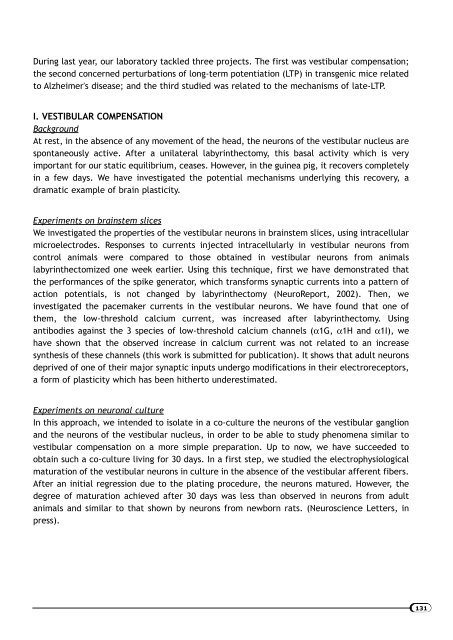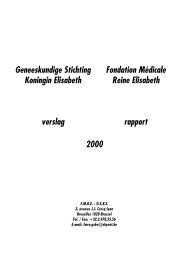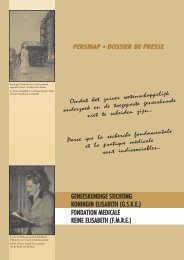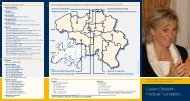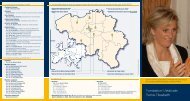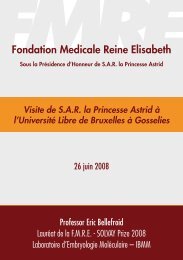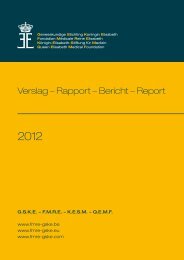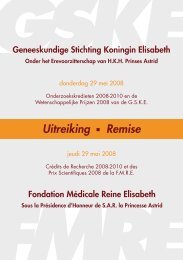Geneeskundige Stichting Koningin Elisabeth verslag - GSKE - FMRE
Geneeskundige Stichting Koningin Elisabeth verslag - GSKE - FMRE
Geneeskundige Stichting Koningin Elisabeth verslag - GSKE - FMRE
Create successful ePaper yourself
Turn your PDF publications into a flip-book with our unique Google optimized e-Paper software.
During last year, our laboratory tackled three projects. The first was vestibular compensation;<br />
the second concerned perturbations of long-term potentiation (LTP) in transgenic mice related<br />
to Alzheimer's disease; and the third studied was related to the mechanisms of late-LTP.<br />
I. VESTIBULAR COMPENSATION<br />
Background<br />
At rest, in the absence of any movement of the head, the neurons of the vestibular nucleus are<br />
spontaneously active. After a unilateral labyrinthectomy, this basal activity which is very<br />
important for our static equilibrium, ceases. However, in the guinea pig, it recovers completely<br />
in a few days. We have investigated the potential mechanisms underlying this recovery, a<br />
dramatic example of brain plasticity.<br />
Experiments on brainstem slices<br />
We investigated the properties of the vestibular neurons in brainstem slices, using intracellular<br />
microelectrodes. Responses to currents injected intracellularly in vestibular neurons from<br />
control animals were compared to those obtained in vestibular neurons from animals<br />
labyrinthectomized one week earlier. Using this technique, first we have demonstrated that<br />
the performances of the spike generator, which transforms synaptic currents into a pattern of<br />
action potentials, is not changed by labyrinthectomy (NeuroReport, 2002). Then, we<br />
investigated the pacemaker currents in the vestibular neurons. We have found that one of<br />
them, the low-threshold calcium current, was increased after labyrinthectomy. Using<br />
antibodies against the 3 species of low-threshold calcium channels (α1G, α1H and α1I), we<br />
have shown that the observed increase in calcium current was not related to an increase<br />
synthesis of these channels (this work is submitted for publication). It shows that adult neurons<br />
deprived of one of their major synaptic inputs undergo modifications in their electroreceptors,<br />
a form of plasticity which has been hitherto underestimated.<br />
Experiments on neuronal culture<br />
In this approach, we intended to isolate in a co-culture the neurons of the vestibular ganglion<br />
and the neurons of the vestibular nucleus, in order to be able to study phenomena similar to<br />
vestibular compensation on a more simple preparation. Up to now, we have succeeded to<br />
obtain such a co-culture living for 30 days. In a first step, we studied the electrophysiological<br />
maturation of the vestibular neurons in culture in the absence of the vestibular afferent fibers.<br />
After an initial regression due to the plating procedure, the neurons matured. However, the<br />
degree of maturation achieved after 30 days was less than observed in neurons from adult<br />
animals and similar to that shown by neurons from newborn rats. (Neuroscience Letters, in<br />
press).<br />
131


